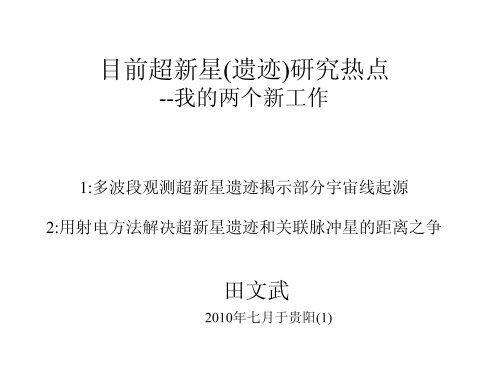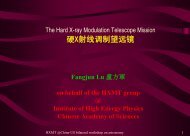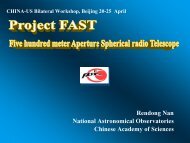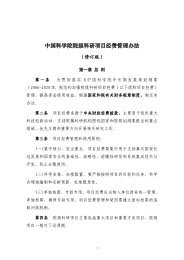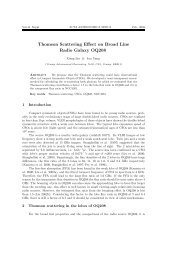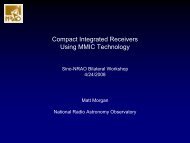超新星遗迹与宇宙线起源及关联脉冲星距离
超新星遗迹与宇宙线起源及关联脉冲星距离
超新星遗迹与宇宙线起源及关联脉冲星距离
Create successful ePaper yourself
Turn your PDF publications into a flip-book with our unique Google optimized e-Paper software.
2009 年 6 月 26 日 的 美 国 《 科 学 》 杂 志 : 一 颗 超 新 星 向 太 空 中 投 射 的 冲 击波 能 够 产 生 携 带 着 巨 大 能 量 的 宇 宙 射 线 粒 子 。 这 一 发 现 将 为 天 文 学 家和 物 理 学 家 提 供 有 关 一 些 宇 宙 中 更 为 神 秘 现 象 的 解 释 。
2008 年 12 月 4 日 的 《 自 然 》: 第 谷 超 新 星 的 回 光德 国 、 日 本 和 荷 兰 的科 学 家 通 过 研 究 遥 远的 星 际 尘 埃 云 团 的 光线 , 确 定 了 “ 死 ” 于436 年 前 的 第 谷 超 新 星是 Ia 超 新 星 的 一 种 ,这 一 发 现 为 暗 能 量 研究 提 供 了 重 要 线 索 。这 张 图 片 由 NASA 的 Spitzer 望 远 镜 , Chandra X- 射 线 空 间 望 远 镜 以 及 西班 牙 Calar Alto 天 文 台 拍 摄 的 照 片 合 成 . 绿 色 和 黄 色 显 示 遗 迹 本 身 的 物 质组 分 , 遗 迹 膨 胀 与 星 际 空 间 的 物 质 相 互 作 用 在 壳 层 最 外 侧 形 成 了 一 个 由极 高 能 电 子 构 成 的 蓝 色 球 壳 , 它 实 际 上 就 是 碰 撞 产 生 的 激 波 。 壳 层 边 缘的 红 色 物 质 是 从 遗 迹 之 外 混 合 进 来 的 星 际 尘 埃 , 它 们 被 壳 层 激 波 加 热 后发 出 了 24 微 米 波 长 的 红 外 辐 射 。 图 中 的 白 色 亮 点 是 前 景 和 背 景 恒 星 .
更 多 : 2010 年 5 月 24 日 的 《 自 然 》: 日 本 广 岛 大 学 副 教 授 川 端 弘 治 率 领 的 研究 小 组 日 前 首 次 观 测 到 的 一 次 轻 量 级 超 新 星 爆 发 .2009 年 7 月 9 日 的 《 自 然 》: 美 国 加 利 福 尼 亚 大 学 欧 文 分 校 7 月 8 日 发 表 新 闻 公报 称 , 该 校 研 究 人 员 利 用 新 方 法 观 测 到 一 次 距 今 110 亿 年 的 超 新 星 爆 发 。 这是 迄 今 发 现 的 年 代 最 久 远 的 超 新 星 爆 发 事 件2009 年 6 月 26 日 的 美 国 《 科 学 》 杂 志 : Fermi 望 远 镜 探 测 到 伽 马 射 线 暴 高 能 光 量子 . 非 常 巨 大 的 恒 星 的 坍 缩 可 产 生 剧 烈 的 爆 炸 并 伴 随 强 烈 的 伽 马 射 线 暴 , 因 而导 致 宇 宙 中 某 些 最 为 耀 眼 的 事 件 .2008 年 7 月 25 日 的 《 科 学 》 杂 志 : Paolo Mazzali 和 一 个 由 超 过 30 位 来 自 世 界各 地 的 共 同 作 者 组 成 的 研 究 小 组 发 现 中 等 级 别 超 新 星 .国 内 年 度 十 大 天 文 科 技 进 展2009:Ia 型 超 新 星 前 身 星 研 究 取 得 重 要 进 展 : 美 国 的 《 新 千 年 天 文 学 和 天 体物 理 学 》 把 Ia 型 超 新 星 列 为 新 千 年 的 主 要 研 究 对 象 之 一2008: 超 新 星 遗 迹 的 新 发 现 和 测 距 革 新 : 给 出 了 观 测 上 的 证 据 证 明 部 分 银 河 系内 宇 宙 线 源 于 超 新 星 遗 迹 ; 用 新 的 HI+CO 方 法 为 超 新 星 遗 迹 / 伽 玛 源 系 统 定 距……
Hertzsprung-Russell 图恒 星 表 面 温 度 和 光 度恒 星 颜 色 和 亮 度 的 分 布 : 揭 示 恒 星 的 演 化质 量 不 同 =》 压 力 不 同=》 温 度 不 同=》 颜 色 不 同=》 绝 对 亮 度 不 同 !=》 寿 命 不 同 !
初 始 质 量 小 于 8 M⊙ 的恒 星 演 化 到 红 巨 星 时候 , 会 形 成 AGB 星 ( 具 有C、O( 电 子 ) 简 并 核 心 和非 常 薄 的 He、H 燃 烧 壳层 ( 热 力 学 上 不 稳 定 )), 最后 因 为 热 脉 冲 , 其 包 层被 抛 射 出 去 形 成 行 星 状星 云 , 而 其 核 心 就 形 成碳 、 氧 白 矮 星低 质 量 恒 星 的 命 运
大 质 量 恒 星的 命 运8-25MSun>25MSun
两 类 超 新 星 的 主 要 特 征超 新 星 类 型 Ia II极 大 光 度 ( 以 太阳 光 度 为 单 位 )爆 发 光 谱约 亮 十 亿 倍无 氢 光 谱 线 , 重 元 素 光 谱 线 很多 , 负 责 人 后 期 铁 线 最 强约 亮 几 亿 倍最 强 的 是 氢 光 谱 线前 身 星 双 星 系 统 中 的 白 矮 星 8-25 倍 太 阳 质 量 恒 星爆 发 原 因爆 发 物 理 机 制吸 积 伴 星 物 质 的 致 密 白 矮 星 质量 大 于 1.4 M_Sun吸 积 白 矮 星 C/O 核 心 的 热 核 大爆 炸恒 星 铁 核 心 引 力 坍 缩从 新 生 中 子 星 表 面 向外 行 进 的 反 弹 激 波残 骸 无 致 密 残 骸 中 子 星遗 迹 内 的 产 物 主 要 是 铁 各 种 元 素 都 有
人 类 历 史 上 有 文 字 纪 录 的 超 新 星 事 件爆 发 时 间光 度 极最 早 发 现 者超 新 星 遗 迹 和 脉 冲 星(AD)大 星 等(SNR and PSR)185 ? -8 中 国 RCW 86/X-ray point source386 ? 中 国 G11.2-0.3 / J1811-1925393 -1 中 国 RX J1713.7-3946 / no PSR1006 -10 中 国 / 阿 拉 伯 SN 1006 / no PSR1054 -5 中 国 / 日 本 Crab Nebula / B0351+211181 -1 中 国 / 日 本 3C 58/ X+Radio J0205+64491572 -4 丹 麦 / 中 / 日 Tycho / SN 1a1604 -3 Kepler Kepler / SN 1a?1667-1680 5 ? John lamsteed ? Cas A / X-ray point source1987 +2.9 Ian Shelton SN 1987A / no PSR
1054 超 新 星 遗 迹 : 蟹 状 星 云 及 其 脉 冲 星 (PSR0531)
1: 甚 高 能 伽 码 超 新 星 遗 迹 HESS J1731-347/SNR G353.6-0.7 的 多 波 段 观 测为 什 么 要 研 究 这 个 系 统 ?
Detect mysterious CRs discovered in 1912 by Victor Hess:A Nobel Prize winner in physics in 1936Images from the HESS Collaboration• Accelerated CRs producesgamma-rays after interactionwith local matter.• Gamma-rays (GeV energiesand above, its trajectories areunaffected by interstellar andgalactic magnetic fields) are atracer of CR accelerators• Shower of particles fromgamma-rays interaction withatoms in the upper atmosphere• Determining type of particle,its energy and direction byreconstructing the showeraccurately
The HESS Telescope920pixes, 5deg FoVcamera• Investigating cosmicgamma rays in the 100GeV energy range• Using the stereoscopicatmospheric Cherenkovimaging technique: mostsensitive technique inthis field so far• Now quite close to thesolution of the Galaciticcomponent of CRsbelow energy 10^15 eV
Totally About 100 VHE Sources
Multi-Band Observations• 1420 MHz continuum and HI+CO spectral lines datagives kinematic distance, age and surrounding densityestimate of G353.6-0.7• New X-ray observations reveal non-thermal X-rayemissions within TeV SNRs G353.6-0.7, suggest anassociation between the X-rays and the Gamma-rays.• High-resolution CO observations to the SNRs revealmolecular clouds associated
Radio (SGPS)+X-ray (XMM+ROSAT)+Gamma-ray (HESS) images of G353.6-0.71. 射 电 图 象 , X- 射 线 图 与 伽 玛 射 线 图象 重 叠2. 探 明 高 能 宇 宙 线 的 产 生 之 迷 仍 是当 今 高 能 物 理 要 解 决 的 关 键 问 题 之一 , 我 们 的 工 作 与 此 密 切 相 关
Spectra (black: EPIC-pn or Suzaku XIS (right panel of the bottomrow); red: EPIC-MOS1; green: EPIC-MOS2) extracted from thewestern ring (left panel of the first row), the eastern ring (right panelof the first row), the compact source (bottom row), and the best-fitmodels. The XMM-Newton spectra are binned to achieve a signal-tonoiseratio greater than 4 and a minimum of 30 counts per bin, whilethe Suzaku spectrum is binned with a minimum of 100 counts.1. Spatiallyresolved X-rayspectra can becharacterizedby a powerlawmodel,with a photonindex of ~ 2,typical nonthermalemission.2. No pulsarand PWNe inthe SNR.
HI and CO line observations to G353.6-0.7SNR G353.6-0.7 has too faint radio emission to obtain its HI absorptionspectrum. Compact HII region G353.42-0.37 is adjacent to the west of the SNR.The picture reveals the HI absorption spectrum features in the range of 9 to -24km/s. Lack of absorption for velocities less than -26 km/s shows G353.42-0.37 isat the near distance (~ 3.2 kpc) of its recombination line velocity (~ -16 km/s).CO emission spectrum from the cloud atthe centre of the SNR G353.6-0.7reveals a bright cloud component at20+/-4 km/s which is same velocity asthe highest value of the HI absorptionfeature of the nearby HII regionspectrum. This supports that G353.6-0.7is at ~ 3.2 kpc too if the cloud isinteracting with the SNR to emit TeVGamma-rays.
总 结1.HESS J1731–347 matches position and extension of radio shellSNR G353.5–0.7; suggestion of limb-brightening in TeVemissions2.Hard X-ray images and spectra reveal non-thermal filamentemissions from the shell, and a CCO at shell center3 Evolved G353.5-0.7 is one of rare class of TeV-emitting SNRs:non-thermal X-ray shells: G347.3–0.5, Vela Jr, SN 1006, RCW86,Cas A, . . .展 望Additional deep radio and X-ray observations needed to studywhole of radio shell and nature of compact X-ray central source.These X-ray/radio studies of TeV sources can reveal new (pulsarwind nebulae and) non-thermal shells: strong Galactic accelerators
2: 解 决 SNR CTB109/AXP 1E2259+586 的 距 离 之 争Motivation: SNR CTB 109 hosts a AXP 1E 2259+586 and is believed to interact with the largemolecular cloud adjacent to its west side, based onits semicircular shape in both X-rays and radio.CTB 109 has an extended X-ray bright region in theinterior, which is thermal in origin and has nomorphological correlation with AXP 1E 2259+586.The lobe likely originates from an interaction of theSNR shock with a cloud at −55 km/s (Sasaki et al.2006, ApJ).
天 文 主 要 测 距 的 方 法
我 们 发 展 的 测 距 方 法 :HI+13CO 谱 线 分 析1: 直 接 环 绕 源 区 选 取 背 景 来 构 建 可 靠的 HI 吸 收 谱 线 。2: 同 时 分 析 同 一 天 体 方 向 的 13CO 发 射谱 线 .
新 方 法 : 检 测 氢 的 自 吸 收 HISA/HINSA+CO 发 射 谱• 什 么 是 HISA/HINSA? HISA is generally produced bytemperature fluctuations in the cold neutral mediumColdH 2CoolH 0WarmH 0WarmH +CO 发 射HISA/HINSA 吸 收HI 吸 收Hot H + 或 连 续 射 电 源
1420MHz 国 际 银 道 面 巡 天
The Astrophysical Journal, 576:169-175, 2002 September 1© 2002. The American Astronomical Society. All rights reserved. Printed in U.S.A.The Distance to Supernova Remnant CTB 109 Deduced from Its EnvironmentRoland Kothes ,1,2 Bülent Uyaniker ,1 and Aylin Yar 1Upper left: Radio continuum imageof the SNR CTB 109, taken fromthe CGPS at 1420 MHz. Theshading goes from 5 (white) to 18K(black). White asterisk: Positionof the X-ray pulsar 1E2259+586.Upper right: CO around CTB 109integrated between -45 and -55 kms -1 . Contours are from 0.2 (white) to4.2 K (black) in steps of 0.5 K.Lower left: H I around CTB 109integrated between -45 and -55 kms -1 . Contours are from 70 (black) to94 K (white) in steps of 3 K.
Fig. 2. Radial velocities of H II regions in the vicinity of CTB 109 as a function oftheir spectroscopic distances. Solid line: Expected behavior according to the flatrotation model with v = 220 km s -1 and R= 8.5 kpc. Dashed line:Radial velocity ofCTB 109.
Fig. 6 H II regions (open circles) and SNRs (open stars) in the vicinity of CTB 109.Dashed lines: Perseus arm as defined by Roberts (1972). Dotted line: Location of themaximum electron density in the Perseus arm as determined by Taylor & Cordes(1993). The names of the individual SNRs are noted. For Sh 156 and the Sh 147/8/9complex, the distances from Wouterloot et al. (1988) are used, and for all other H IIregions, the spectroscopic distances listed in Brand & Blitz (1993). The distances forthe SNRs Cas A and Tycho were taken from Reed et al. (1995) and Chevalier et al.(1980), respectively.
The Astrophysical Journal, 650:1070-1081, 2006 October 20© 2006. The American Astronomical Society. All rights reserved. Printed in U.S.A.Distances to Anomalous X-Ray Pulsars Using Red Clump StarsMartin Durantand Marten H. van KerkwijkDepartment of Astronomy and Astrophysics, University of Toronto, 60 St. George Street,Toronto, ON M5S 3H8, Canada
Left: 1420-MHz continuum image of CTB 109 and the near H IIregion Sh 152. Right: CO emission at −51 km/s with contours (8,15, 21, 29, 100 K) of the continuum emission. The left-handpanel shows boxes (both green and red) used for extraction of HIspectra (see text) and centred at for box 1, for box 2, for box 3, ,for box 4, for Sh 152 and for CTB 109, respectively.
CTB 109 (top) shows a highest HIabsorption velocity of −56 km/s.Sh 152 (bottom) shows the highestabsorption velocity of −65 km/s.The CO spectrum shows narrowCO emission at −48 to −54 km/s.The fact that the highest radialvelocities of HI absorption featurestowards both CTB 109 (−56 km/s)and Sh 152 (−65 km/s) are largerthan the recombination linevelocity (−50 km/s) of Sh 152confirms the existence of a velocityreversal within the Perseus Arm.This reversal explains why the HIgas at higher radial velocity is infront of Sh 152 which is at lowerradial velocity.
• Roberts’ model (1972) and Foster model (2007) for thePerseus armRobert model has errors but do not alter the generalconclusions of this important work.
1.The molecular cloud has cold HIcolumn density large enough toproduce HI self-absorption (HISA)and HI narrow self-absorption(HINSA) if it was at the near side ofthe velocity reversal.(1).NHI = 1.82 × 10^{18}τΔv Ts;(2).THISA= (TB(v) −Ts)(1 − e^{−τ})2.Absence of both HISA andHINSA indicates that the cloud is atthe far side of the velocity reversalwithin the Perseus Arm.Conclusion: CTB 109 is at far sideof velocity reversal, i.e. ~ 4kpcTian, Leahy, Li, MNRAS, 2010, 404, L1
FAST 望 远 镜 - 历 史 的 机 遇 和 光 明 的 未 来• 一 棵 在 贵 州 刚 拱 出 地 面 的健 壮 的 小 树 ( 苗 ). 前 面 很 多人 为 这 一 刻 付 出 艰 辛 努 力作 出 巨 大 的 贡 献 .• 前 人 栽 树 , 后 人 乘 凉 . FAST在 成 为 参 天 大 树 前 , 需 要 更多 的 年 轻 人 为 其 精 心 护 理 :施 肥 , 杀 虫 , 防 冻 , 防 火 等 等 .我 们 不 是 一 单 纯 的 乘 凉 后人 , 也 是 中 国 天 文 史 中 壮 丽诗 篇 的 参 与 人 和 书 写 者 .• 让 FAST 成 为 真 正 的 对 人 类有 知 识 性 贡 献 的 世 界 级 望远 镜 , 我 们 大 有 可 为 !


